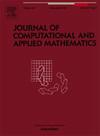An improved proximal alternating linearized minimization algorithm and its inertial Bregman extension for structured nonconvex nonsmooth optimization problems on Riemannian manifold
IF 2.1
2区 数学
Q1 MATHEMATICS, APPLIED
Journal of Computational and Applied Mathematics
Pub Date : 2025-07-04
DOI:10.1016/j.cam.2025.116886
引用次数: 0
Abstract
In this paper, we study a class of nonconvex and nonsmooth optimization problems with a specific structure. The objective function consists of the following components: a nonsmooth function in Euclidean space, a smooth function on a manifold, and a smooth coupling function linking of these two variables. By exploiting problem’s composite structure, we propose an improved version of the proximal alternating linearized minimization method. This algorithm employs a splitting technique, where the nonsmooth subproblem defined in the Euclidean space is solved using a forward–backward operator, and the smooth manifold subproblem is addressed using a Riemannian gradient step. We further extend this algorithm by introducing an inertial Bregman variant, which incorporates inertial step and Bregman regularization to improve both efficiency and robustness. We provide a theoretical analysis of the proposed algorithms and establish their iteration complexity for obtaining an -stationary point under mild assumptions. Finally, we present numerical experiments on sparse principal component analysis to verify the effectiveness of the proposed algorithms.
黎曼流形上结构非凸非光滑优化问题的改进近端交替线性化最小化算法及其惯性Bregman扩展
本文研究了一类具有特定结构的非凸非光滑优化问题。目标函数由欧几里得空间中的非光滑函数、流形上的光滑函数和连接这两个变量的光滑耦合函数组成。利用问题的复合结构,提出了一种改进的近端交替线性化最小化方法。该算法采用分裂技术,其中在欧几里得空间中定义的非光滑子问题使用正反向算子求解,而光滑流形子问题使用黎曼梯度步进求解。我们进一步扩展了该算法,引入了惯性布雷格曼变体,该变体结合了惯性步进和布雷格曼正则化,以提高效率和鲁棒性。我们对所提出的算法进行了理论分析,并建立了在温和假设下获得ϵ-stationary点的迭代复杂度。最后,我们给出了稀疏主成分分析的数值实验来验证所提出算法的有效性。
本文章由计算机程序翻译,如有差异,请以英文原文为准。
求助全文
约1分钟内获得全文
求助全文
来源期刊
CiteScore
5.40
自引率
4.20%
发文量
437
审稿时长
3.0 months
期刊介绍:
The Journal of Computational and Applied Mathematics publishes original papers of high scientific value in all areas of computational and applied mathematics. The main interest of the Journal is in papers that describe and analyze new computational techniques for solving scientific or engineering problems. Also the improved analysis, including the effectiveness and applicability, of existing methods and algorithms is of importance. The computational efficiency (e.g. the convergence, stability, accuracy, ...) should be proved and illustrated by nontrivial numerical examples. Papers describing only variants of existing methods, without adding significant new computational properties are not of interest.
The audience consists of: applied mathematicians, numerical analysts, computational scientists and engineers.

 求助内容:
求助内容: 应助结果提醒方式:
应助结果提醒方式:


